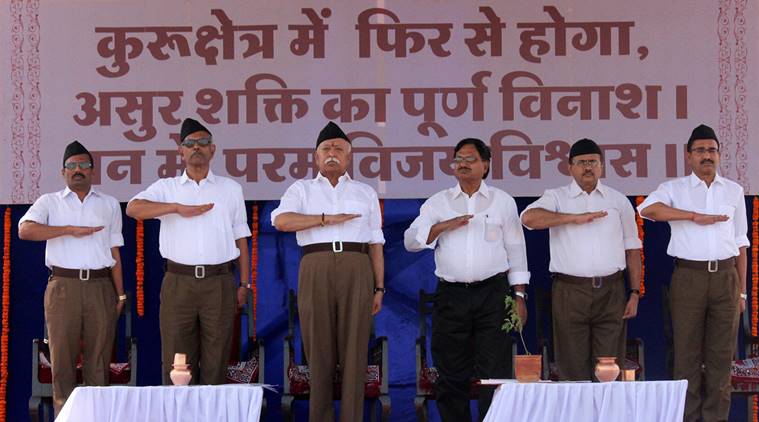
The guest list included Anand Mahindra, Assam Chief Minister Sarbanand Sonowal and his cabinet colleague Himanta Biswa Sarma. No, this wasn’t an investment mela to woo industrialists to the northeastern state. Rather, this was an event in the heart of India, in Nagpur, the shraddha kendra (or place of reverence) for the 4.5 lakh-odd members nationwide of the 92-year-old Hindu nationalist Rashtriya Swayamsevak Sangh (RSS).
For 25 days between May 15 and June 8, the Hedgewar Smarak Samiti in Reshimbagh was home to 914 men – in the 18-to-40 age group – who were ready to be anointed as Sangh workers after short periods of training spread across three years. They came from far and wide – from all 42 prant or provinces of the nation, from varied professions, including business, services, farming, engineering and medicine.
All of them bore the expenses and followed a strict routine that started from 4 am till 10 pm. The course material for the final year: teamwork, renunciation, discipline and devotion towards a larger cause. The participants get trained in dand (staff), niyudha (unarmed combat), ghosh (band), vyayam yoga (physical exercise), yogasana (yoga) and the like. RSS Sarsanghchalak Mohan Bhagwat in the valedictory address on Thursday expressed confidence that the trainees will live up to rising expectations.
The 25-day camp was significant for another reason: it was the first training camp that witnessed the change in uniform from khaki knickers to “full brown pants”.
ET Magazine travelled to Nagpur, and caught up with RSS patriarch MG Vaidya and his son Manmohan Vaidya, who is the publicity chief, and took a peek into Hedgewar Bhavan, the headquarters in the Mahal area of Nagpur.
The Hedgewar Smarak Samiti at Reshimbagh in Nagpur is a three-storey building with a sprawling ground on which the RSS holds various events. One such was the valedictory function of the summer camp for the final year course of trainees earlier this week. The Smarak Samiti, though, is not the RSS’s national headquarters. The nerve centre is the high-security, high-walled premises in Mahal area, roughly 2 km from the Smarak Samiti, called Hedgewar Bhavan. The building that was originally the barn of a lieutenant of raja Lakshman Singh Bhonsle was in a dilapidated condition in the early 1900s and often used by freedom fighters to hide and hold meetings against the British.
The RSS purchased the bungalow in the late 1920s, but not before founder Keshav Baliram Hedgewar had to apparently dispel rumours that it was haunted. This was the RSS’s first shakha. “This is the only property that is in the name of the sarsanghchalak. And it is automatically passed on to the next one,” explains RSS pracharak (full-time worker) Vikas Telang.
The HQ was built up in three phases: in 1945-46, 1996 (when a three storey building was added) and in 2006. The Mahal outpost may be the main office, but hardly any large-scale function of the RSS is held there; those take place at the Samiti. Mahal primarily serves as the abode of all-India functionaries, including sarsanghchalak Mohan Bhagwat and his deputy and sarkaryavah Bhaiyaji Joshi, and for one-on-one meetings of the sarsanghchalak. A few elderly RSS functionaries who are no longer officials also live here. As Telang explains the structure of the building, a bell rings. It is 3.30 pm and it is tea time.
The daily routine includes reciting the ekatmata stotra at 5.30 am, breakfast at 8, lunch at noon, tea at 3.30 pm, snacks at 5 pm and dinner at 8. The rooms inside the building are simple and have coolers to beat the heat. “Mohanji (Bhagwat) has composed many ghosh (drum) rachanaye (compositions) himself,” lets on Telang, and goes on to explain a few unwritten protocols.
“The sarsanghchalak and sarkaryavah (all-India general secretary) will never travel in the same vehicle even if they are going to the same place.” The HQ has a museum on the second floor that is filled with life-size portraits of previous chiefs along with their personal belongings and mementos. One of the exhibits: a cylindrical metal tiffin of Hedgewar, or Doctorji, in which he used to apparently carry 40 rotis. Incidentally, it is the only belonging of Doctorji kept in the museum. On the grounds adjoining the HQ, a bunch of boys play football.
“They are children of the locals; we allow them to play inside as the huge ground around the building is what they want,” says Telang. The takeaway isn’t exactly subtle. “The more openly one looks at the organisation, the more close one gets to the reality of the RSS,” says Telang.
Courtesy: The Economic Times

